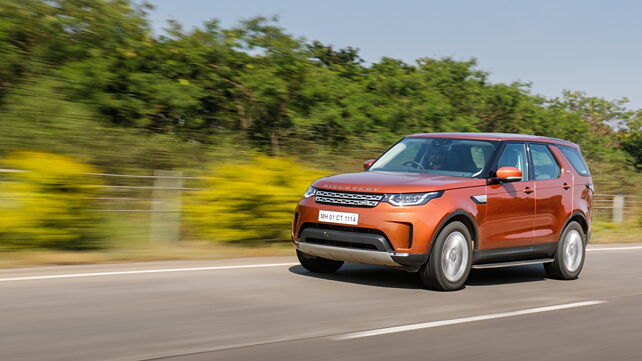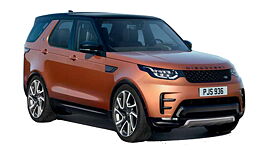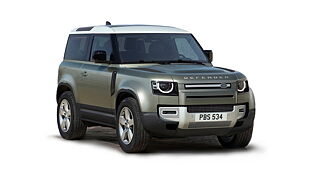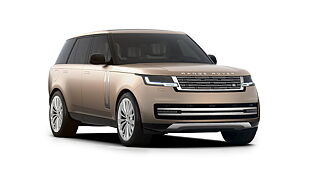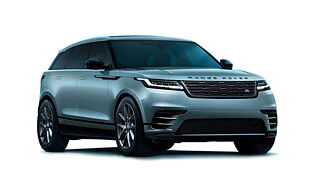What is it?

Why would I buy it?
For its unparallel space and comfort levels. Also, it performs well even after you've run out of tarmac.
Why would I avoid it?
Can get cumbersome within city limits. Doesn't steer as well as the competition.
Although a brilliant family car, the previous-gen Land Rover Discovery (the LR4) was underwhelming to drive and felt utterly old-school. The fast-evolving competition didn’t do it any favours either and with the buying trends changing significantly all the time, Land Rover has had to add to the Disco’s arsenal, while retaining all its practical attributes and off-road ability.
Say hello to the all-new 2017 Discovery which, as you may have figured by now, resembles the Range Rover and in some ways, the smaller Discovery Sport. Nonetheless, it’s a big old thing and there’s no getting away from its immense bulk. Measuring nearly 5 meters in length (4,970mm) and riding 1,846mm off the ground, the new Discovery demands attention and thanks to its Range Rover-like styling cues, gets plenty of it.

In comparison to the previous car’s top-heavy stance and boxy lines, the 2017 model looks very different but is still unmistakably a Discovery. After all, it retains some of the design features like the distinctive stepped roofline and a rather high waistline. At the rear, you will find a new single-piece tailgate design, which has replaced the previous horizontally split configuration. The taillights, too, are now stacked horizontally and look particularly sporty. Lastly, the offset rear number plate is a clear nod to the previous-gen Discos; however, we aren’t too fond of this new layout as it makes the rear-end look out of place with the rest of the design.
Getting in and out of the Discovery can be a task. Thankfully, to aid entry and exit, it lowers itself by an initial 15mm when the ignition is turned off or someone unclips their seat belt. When the door is opened, the car is lowered by an additional 25mm for easier entry/exit. The Disco, then, returns to its automatic ride height within seconds of driving. This is all thanks to the air suspension which is standard across all variants.

How is it on the inside?

Like the exterior, the new Discovery’s cabin benefits from the general layout and design of the Range Rover and the Sport. You get the same well layered albeit slab-like dash with a huge centre console and a snazzy-looking steering wheel. And while all the controls feel hard-wearing and durable, the air vent plastics and climate control switches could be better finished.
The Discovery’s cabin is immensely practical with multiple usable storage spaces. Besides the usual array of glove boxes and door pockets, the Disco gets a large storage box behind the rotary gear selector. There’s even a fairly big cool box under the front armrest which is a really neat feature. Lastly, there’s the hugely configurable seating arrangement in the 7-seater variant as all three rows are electrically adjustable. They feature anti-pinch and stall detection tech – if the seat is folding and it detects something, it will stop and then unfold to avoid crushing the item. Alternatively, if the seat is folded flat with an item stored on top, the seatback will not raise.

We absolutely love the high and mighty driving position and the excellent all-round visibility. As for the seat comfort, the front seats are massive and offer immense side support and even under-thigh support – they are large enough to keep you comfortable during long hauls. Similarly, there is plenty of room at the back, with a rear bench that is broad and spacious enough to accommodate three adults easily. Although the rear bench is set a tad bit low, it is superbly contoured and the low seating translates to plenty of headroom. Sadly, this new model cannot match its predecessor when it comes to the third-row seating comfort – the pair of seats is smaller and to make matters worse, there’s noticeably less thigh support. Mind you, the Discovery still has one of the best third row seats but you end up feeling short-changed because the previous car’s third row was a whole lot more accommodating.

The user interface for the 10-inch infotainment screen appears basic in comparison to some of the rivals, however, there’s no denying the quality output from the 14-speaker premium audio system. As for the rest of the features, the Discovery is fully loaded and comes with adaptive LED headlights, adaptive cruise control, lane keep assist, 360-degree parking, a head-up display, 4-zone climate control, interior mood lighting and a tonne of safety tech. However, we would like to add that a lot of features from the spec list are optional extras.

How does it drive?

The Discovery now uses Land Rover’s aluminium architecture that was first introduced in the latest-gen Range Rover. Thanks to the aluminium chassis and body panels, the Discovery has managed to shed a mahoosive 480kg over its predecessor. However, at over 2.1 tonnes for this petrol-powered version, the Disco is still a heavy car. And although I am tempted to knock the 3-litre V6 engine for not being the ideal motor for this car, it has to be said that it actually feels effortless as it moves this gigantic vehicle towards the horizon. Developing 340bhp and 450Nm of torque, this supercharged powerhouse is the same engine that Jaguar uses in its F-Type sports car and in here, it pulls hard especially in the midrange and screams its way to the 6,500rpm redline with a distinct whine from the supercharger.
It’s no tour de force by any means, but this motor’s got more than enough punch to get the Disco up to speed and keep it there without struggling. In fact, the Discovery can get up to highway speeds quickly and execute overtaking with ease from say 80 to 90kmph. The engine’s pulling power, which is stronger than what the numbers suggest, is no doubt aided by the brilliant 8-speed ZF gearbox that delivers creamy smooth yet quick gearshifts.

The previous Discovery’s steering felt disconnected especially at high speeds, but this new one doesn’t. Sure, it doesn’t have the same taut and direct feel to the steering that a BMW X5 has but there is some noticeable improvement over the old model. Make no mistake, the Disco rolls a lot and feels spongy around corners but like its predecessor, it absolutely devours bad roads. It has an inherent ability to iron out even the sharpest of bumps and rutted imperfections with ease. Better still, the jolts typically experienced in full-size traditional SUVs are next to none. All in all, the Discovery remains thoroughly composed at low speeds but at highway speeds, there is constant vertical movement and that wallowy feeling that air suspension-equipped cars are bundled with.
A lot of the buyers are unlikely to take their Discovery off-road, but it is reassuring to know that it is more than capable at dealing with rough stuff. As standard, you get Land Rover’s full-fledged Terrain Response System and a two-speed transfer box that offers selectable high and low range gears. The system offers a standard 50/50 torque split between front and rear wheels, but uses sensors to distribute torque between the wheels depending on slippage. It’s a 'shift on the move' system which allows the driver to swap between high and low ratios without having to stop the vehicle, at speeds of up to 60kmph.

Should I buy one?

The 2017 Land Rover Discovery isn’t the most luxurious full-size SUV and at Rs 1.30 crores (on-road, Mumbai) for the top-spec diesel version, it’s certainly not cheap either. However, if you value practicality and long-distance cruising you will surely appreciate the Disco’s massive interior, flexible seating option and effortless performance. So if you are after a well-built traditional SUV with a genuine off-road ability instead of a glitzy and unashamedly road-focused SUV, the new Discovery makes for a worthy choice.
Where does it fit in?

The new Discovery range is priced between Rs 68.05 lakhs and Rs 1.03 crore (ex-showroom), depending on the engine and trim level. It goes up against other luxury family SUVs like the Mercedes-Benz GLS, Audi Q7 and the Volvo XC90.

